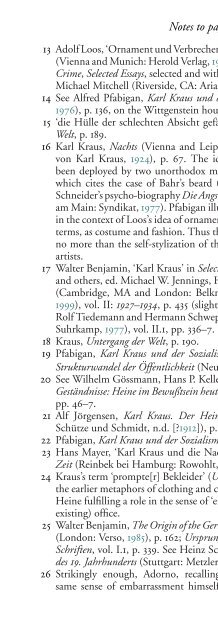READING HEINRICH HEINE
READING HEINRICH HEINE
READING HEINRICH HEINE
Create successful ePaper yourself
Turn your PDF publications into a flip-book with our unique Google optimized e-Paper software.
Notes to pages 8–15 267<br />
13 Adolf Loos, ‘Ornament und Verbrechen’ in Sämtliche Schriften, ed. Franz Glück<br />
(Vienna and Munich: Herold Verlag, 1962), p. 284: translated in Ornament and<br />
Crime, Selected Essays, selected and with an introduction by Adolf Opel, trans.<br />
Michael Mitchell (Riverside, CA: Ariadne Press, 1998), p. 172 (modified).<br />
14 See Alfred Pfabigan, Karl Kraus und der Sozialismus (Vienna: Europaverlag,<br />
1976), p. 136, onthe Wittgenstein house.<br />
15 ‘die Hülle der schlechten Absicht gefällig zu machen’, Kraus, Untergang der<br />
Welt, p.189.<br />
16 Karl Kraus, Nachts (Vienna and Leipzig: [Kurt Wolff] Verlag der Schriften<br />
von Karl Kraus, 1924), p. 67. The idea of an aesthetics of the phrase has<br />
been deployed by two unorthodox monographs on Kraus: Pfabigan’s study,<br />
which cites the case of Bahr’s beard (p. 137), and, following him, Manfred<br />
Schneider’s psycho-biography Die Angst und das Paradies des Nörglers (Frankfurt<br />
am Main: Syndikat, 1977). Pfabigan illustrates Kraus’s resistance to the ‘phrase’<br />
in the context of Loos’s idea of ornament, which Kraus understands, in human<br />
terms, as costume and fashion. Thus the popularity of the beard is attacked as<br />
no more than the self-stylization of those who like to think of themselves as<br />
artists.<br />
17 Walter Benjamin, ‘Karl Kraus’ in Selected Writings, trans. Rodney Livingstone<br />
and others, ed. Michael W. Jennings, Howard Eiland, and Gary Smith, 3 vols.<br />
(Cambridge, MA and London: Belknap Press of Harvard University Press,<br />
1999), vol. II: 1927–1934, p.435 (slightly modified); Gesammelte Schriften, ed.<br />
Rolf Tiedemann and Hermann Schweppenhäuser, 7 vols. (Frankfurt am Main:<br />
Suhrkamp, 1977), vol. II.1,pp.336–7.<br />
18 Kraus, Untergang der Welt,p.190.<br />
19 Pfabigan, Karl Kraus und der Sozialismus, p.141, citing Jürgen Habermas,<br />
Strukturwandel der Öffentlichkeit (Neuwied: Luchterhand, 1971), p. 227.<br />
20 SeeWilhelm Gössmann, Hans P. Keller, Hedwig Walwei-Wiegelmann (eds.),<br />
Geständnisse: Heine im Bewußtsein heutiger Autoren (Düsseldorf: Droste, 1972),<br />
pp. 46–7.<br />
21 Alf Jörgensen, Karl Kraus. Der Heinefresser und die Ursachen (Flensburg:<br />
Schütze und Schmidt, n.d. [?1912]), p. 13.<br />
22 Pfabigan, Karl Kraus und der Sozialismus,p.21; see also p. 17.<br />
23 Hans Mayer, ‘Karl Kraus und die Nachwelt’, in Ansichten. Zur Literatur der<br />
Zeit (Reinbek bei Hamburg: Rowohlt, 1962), p. 74.<br />
24 Kraus’s term ‘prompte[r] Bekleider’ (Untergang der Welt,p.197) suggests both<br />
the earlier metaphors of clothing and costume, as of a superficial effect, and of<br />
Heine fulfilling a role in the sense of ‘ein Amt bekleiden’ – to hold an (already<br />
existing) office.<br />
25 Walter Benjamin, The Origin of the German Tragic Drama, trans. John Osborne<br />
(London: Verso, 1985), p. 162; Ursprung des deutschen Trauerspiels, Gesammelte<br />
Schriften, vol. I.1, p.339. See Heinz Schlaffer, Faust Zweiter Teil. Die Allegorie<br />
des 19. Jahrhunderts (Stuttgart: Metzler, 1981).<br />
26 Strikingly enough, Adorno, recalling a remark of Proust, will note the<br />
same sense of embarrassment himself vis-à-vis Kraus’s own Sittlichkeit und
















